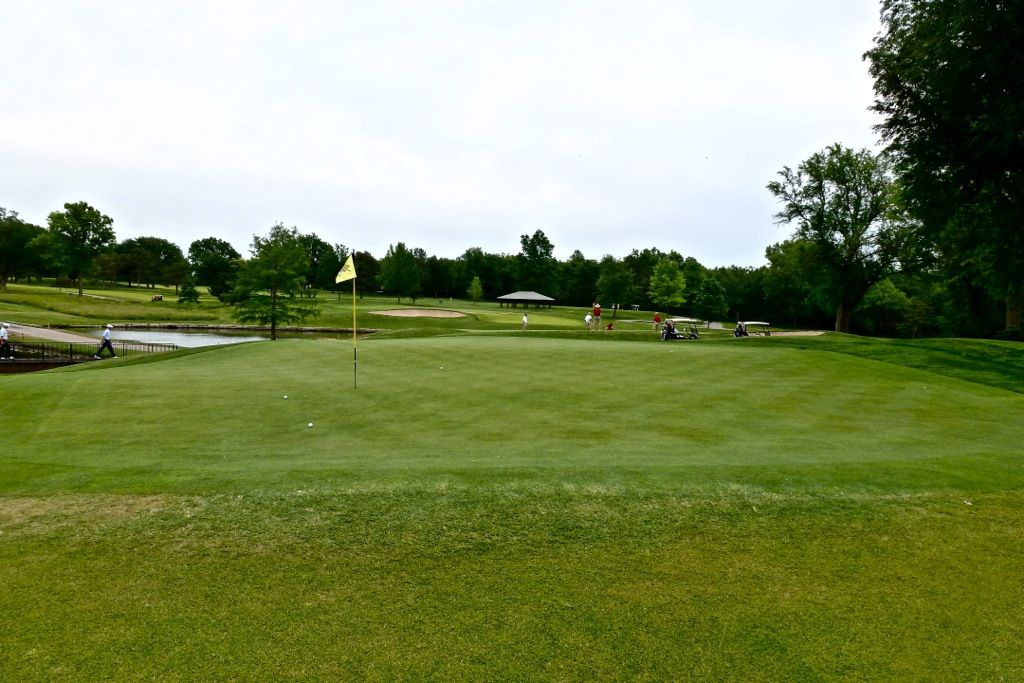Wichita, Kansas, United States
Architect: Bill Diddel (1950)
6,814 Yards, Par 71
Rating/Slope: 73.3/132
My Quick Review: The perfect compliment to a day at Prairie Dunes
Wichita Country Club has a tremendous history of holding championships, including the US Women's Open, the Trans-Miss, Women's Mid-Am and the US Senior Am, and yet the Club remains largely unknown. The routing is intimate on a tight piece of property with holes that seemingly wind around one another. The greens are a tremendous set -- varied and nasty. Let's hope Wichita CC is never awarded a US Open as surely a prerequisite would be a flattening of many greens.

As mentioned, the holes wind in a circular motion, and as a result many dogleg left. This trend starts early as the opening pair of par-4s move left around trees. At both holes the main interest is found on the green. The first green sits at-grade and rolls with the land...

While the second green relies more on tilt and a huge know at its back-centre...

The third is a mid-length par-3s that connects the golfer to the next hole. The fourth is a solid par-5 and reachable in two for the bombers, but only if strategic bunkering on the left is challenged to leave a second shot that is clear of the trees and bunkers pictured...

The fifth runs along the boundary of the property and probably was a more interesting hole before a back-tee added some 40 yards to the hole. Note the fascinating landforms in the centre of the fairway...

The 6th features one of the most severe greens I've ever seen. The green slopes noticeably from back-to-front and a massive spine runs down its centre before banking hard to the left.



The 7th is another short par-4 that moves left and features the diagonal spine on its green.

8 and 9 are big golf holes. The 8th is a par-3 that stretches to near 220 yards and begs for a drawing tee shot.

The 9th is the perfect microcosm for the golf course as a whole. The hole moves left, trees impede slightly on the line of play, the bunkering is simple and strategic, and the green is extreme. If the greens were softened, the 9th would probably be the first to be altered.



At 447 yards the 10th is the longest par-4 on the golf course and offers a surprisingly small green as a target.

The 11th feels like a MacRaynor Short with noteable internal contouring...

The 12th hole is now a bizarre par-4, driveable by some, and a hole where trees now dictate strategy. It is almost impossible to reconcile the current 12th with the 12th in the original routing.
The 13th is a pretty par-4 where the Line of Instinct draws the golfer to the left and toward the water.


At the 15th trees again protect the ideal line and golfers wishing to leave a short approach must play a rope hook. The property is mostly flat but in places, as seen in the rolling 13th fairway, the land is well used.



The 17th is another longish par-3 at 190 yards. I may have forgotten it, if not for my chip-in, which meant I had 9 putts through 8 holes on the back-nine!

18 is one of the best holes on the golf course. The fairway narrows the longer the drive...

And deceptive bunkering make depth perception difficult and hide much of the putting surface...

Which, not surprisingly, is highly contoured. Oh, I chipped-in again on 18!


No comments:
Post a Comment